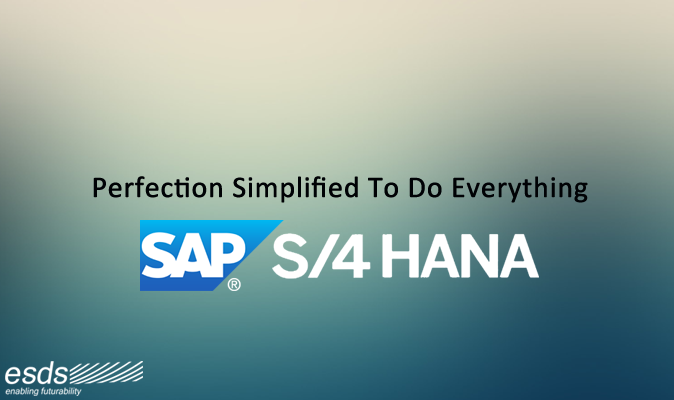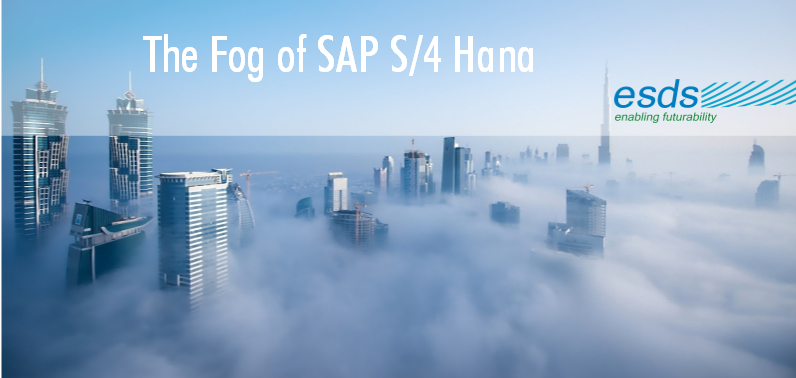5 Main Questions Asked by the Market about SAP S/4 Hana

S/4 Hana, the new SAP ERP is a major breakthrough in software packages product line!
SAP always mentioned that the objective of its strategy around Hana was to rewrite its Software to take advantage of in-memory. But there is still a major disruption of equilibrium in the market for ERP.
Remember that the current versions of SAP ERP – Business Suite, mostly run on the Oracle database. Between 60 to 70% of installed SAP base employs Oracle DBMS, though the main rival of German elsewhere on the package on the segment.
Announcement of S/4 Hana was actually a bold move from SAP, because it involves very fundamental decisions for customers. SAP also appears as a precursor for a vast movement of simplification combining both a simplification of business processes and all underlying technology layers.
In fact, companies – especially those already running on SAP applications or providing SAP Hosting Solutions (such as ESDS – SAP on eNlight Cloud) have all the time to evaluate their strategy. The arrival of S/4 Hana is turning a decisive factor for the company. But before proceeding ahead, one must check the 5 main questions asked by the market.
1) Hana is a risky bet?
Of course it is the first impression with S/4 Hana. The database packages available in the market, designed for data modeling are mostly compatible with it. However, Oracle DB, SQL Server or DB2 also offers in-memory options, but according to SAP, with different data patterns to that prevailing in Hana.
The stakes are obviously enormous. For an instance, Oracle, market observers believe that SAP would be the first customer of its US rival in the World, via the resale of database license to its users. The consequences are heavy for Microsoft, explains that 65,000 SAP instances are running on Windows Servers.
Two thirds of which is associated with SQL Server, we ensure that at this stage SAP may refuse to certify the new features SQL Server in-memory. So the question would come at the desk whether this is customer locking strategy or a real technical constraint?
This close link between database and software is not a hurdle, however, it is absurd. Oracle with its Exadata provides BI, also presents a bundled offer combining BI application, database and platform. In addition, in a Cloud approach when the company becomes a consumer of services, it seems clear that the interest of a client for architecture (database and platform) clearly takes second place to the benefit of increased functional coverage and an optimized TCO.
2) What is the future for the Business Suite?
SAP has beautifully ensured that innovation output of its laboratories will not be reserved for S/4 Hana only. So it will continue to improve Business Suite beyond regulatory adjustments and security updates. However, this is obviously a risk, but it is not new, all SAP innovations already are running for several months exclusively around Hana. Innovations should indeed happen primarily on the new platform, simply because it is the real-time nature of the platform for innovations. However, that the respective road-maps from R/3 (the original name of the business Suite) and S/4 Hana are not yet finalized.
3) What road-map for migration?
For now, only the migration of Business Suite to Hana is well marked. This is a key step that offers performance gains, but also paves the way for the adoption of new application components based on S/4 Hana such as Simple Finance. The application migration will be phased with scenarios that will be unveiled in the coming months. For example, the arrival of Single Logistics at year end, however, these migration scenarios are awaiting development (a key point to note).
Both site open in parallel: one technical and the other financial. The migration of ECC6 (last version of the central component of Business Suite) with or without Hana to S/4 Hana remains to mark both on the technical aspects (integration level between the intermediate versions of S/4 Hana Simple Finance and current ECC modules 6, migration of existing arrangements) and financial (additional licenses and pricing).
The installed base will not be kept out as SAP provides smooth transitions both in economic terms and on a functional level. Also, it depends on the Oracle pricing strategy and the relationship between the two companies. However, the competition that is established between these two companies must lead to negotiations which should benefit businesses.
4) How to speed up the migration?
Four elements must be taken into account during the migration. First, the investment in a dedicated technical environment, added to the need to revisit the ABAP code for each transaction which is consistent with the logic of the columns in databases. Simple transportation tables on Hana certainly help to increase performance (x4 to x29) but not exceptional. On the other hand, the contribution of performance should be an opportunity to rethink business processes, thanks to the arrival of previously unattainable functions (resupply in real-time, predictability and calculation of projections, real-time analysis, etc…). Finally, Hana has an impact on the architecture of information systems. This is also the whole meaning of the integrated Single form S to the name S/4 Hana. Why struggle in managing complexity, if the latter involves companies in vicious circle (complexity = time = costs).
In short, the project is multi-dimensional. As SAP draw on Business Suite migration path to S/4 Hana, given the investment is made to implement the ERP Suite. In addition, ROI calculation made upon the acquisition of ECC, which are yet to materialize. An additional investment demand (particularly towards Hana platform as part of migration ‘Simple’) cannot be justified today only through a ‘pain points’: performance acute problem, growth vertiginous data, heterogeneity of the SI, etc…
An assessment shared by the users, for them the only criteria dictating eventual migration that lies in the cost/value made by S/4 Hana. Ultimately, it will depend on TCO (cost) and the effort that this will migrate to ECC6 S/4 Hana. If this can happen without too much pain, the brakes should be relatively small, but it will take 10 years as the majority has finished migrating. It is long, as any major transformation process. But if the migration required rewriting much of the application (that we have no idea at this stage), SAP could probably be losing some of its customers on the way. So its partners are expected on their ability to offer traditional platform for migration to Hana controllers, reducing costs on the purely technical aspect of the project.
5) The ERP in the Cloud: too soon?
The focus on the Cloud has increased, at least in terms of communication. With S/4 Hana, the company mentioned that Simple Logistics (expected by the end of the year) and should be the first package to be available initially in the Cloud, before being available in Traditional Version. But that seems a little off in the Europe where companies are reluctant to turn the heart of their ERP functions in the Cloud.
SAP also significantly deflected the speech, explain that “S/4 Hana message is not just a message, as it says Cloud-First”, but a message centered on maximum choice. Each customer can choose the deployment mode that matches its own strategy: public cloud, private cloud, hybrid cloud or on-site implementation.
The double merit to position SAP face is purely in the hand of Cloud players, and offers the choice of mode of deployment for customers. Based on a S/4 Hana which is ready for the Cloud environment, this is not SAP that seems to impose time, but rather the market that grew by stratum (private cloud, public cloud) and which requires companies to be ready.
- Why is Microsoft Turning Its Focus on Linux? - March 29, 2016
- Migrating Enterprise Data to the Cloud – A Checklist - November 30, 2015
- Why is your private cloud beginning to fail? - October 20, 2015
